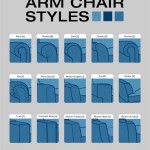How To Clean Sofa Arms Effectively
Sofa arms, due to their frequent contact with hands and potential spills, are particularly susceptible to accumulating dirt, oils, and stains. Regular and proper cleaning is essential to maintain the overall appearance and hygiene of the sofa. This article provides comprehensive guidance on effective methods for cleaning sofa arms, covering various fabric types and addressing common types of stains.
Identifying the Fabric Type
Before initiating any cleaning process, it is paramount to identify the fabric composition of the sofa arms. This information is generally available on a tag attached to the sofa. Common codes found on these tags indicate appropriate cleaning methods. The most commonly encountered codes are:
W: Indicates the fabric can be cleaned with water-based cleaning solutions.
S: Denotes that only solvent-based or dry cleaning products should be used.
WS: Suggests that either water-based or solvent-based cleaners are safe for use.
X: Signifies that professional cleaning is recommended, or vacuuming only is permitted.
Failing to adhere to the manufacturer's recommendations can result in irreparable damage, including discoloration, shrinkage, or fabric degradation. Always consult the care label before proceeding.
General Cleaning Steps for Most Fabrics (W or WS)
Assuming the fabric is suitable for water-based cleaning (W or WS code), the following steps provide a general guideline for cleaning sofa arms:
Vacuuming: Begin by thoroughly vacuuming the sofa arms using an upholstery attachment. This removes loose dirt, dust, crumbs, and pet hair. Pay particular attention to crevices and seams where debris tends to accumulate. A crevice tool can be especially useful for reaching these difficult areas.
Spot Testing: Before applying any cleaning solution to the entire sofa arm, perform a spot test in an inconspicuous area, such as the back or underside of the arm. This will help determine if the solution causes any adverse reactions, such as discoloration or damage to the fabric. Apply a small amount of the cleaning solution, let it sit for a few minutes, and then blot it with a clean, white cloth. Observe the area for any changes in color or texture. If no adverse reaction is observed, proceed with cleaning the entire sofa arm.
Preparing the Cleaning Solution: For general cleaning, a mild soap solution is often effective. Mix a small amount of mild dish soap (e.g., a few drops) with warm water in a bowl. Avoid using harsh detergents or abrasive cleaners, as these can damage the fabric. Alternatively, a commercially available upholstery cleaner designed for the specific fabric type can be used. Ensure the cleaner is pH-neutral and free of harsh chemicals.
Applying the Cleaning Solution: Dampen a clean, soft cloth with the cleaning solution. Avoid saturating the cloth; it should be damp, not dripping wet. Gently blot the stained or soiled areas of the sofa arm, working in small sections. Avoid rubbing vigorously, as this can spread the stain or damage the fabric fibers. Use a circular motion to lift the dirt and grime. Frequent rinsing of the cloth with clean water is essential to prevent redepositing the dirt back onto the fabric.
Rinsing and Drying: After cleaning, remove any remaining soap residue by blotting the sofa arm with a clean, damp cloth. Repeat this process several times until all traces of the cleaning solution are gone. Once rinsed, allow the sofa arm to air dry completely. To speed up the drying process, use a fan or open windows to improve ventilation. Avoid using a hairdryer or placing the sofa arm in direct sunlight, as this can cause shrinkage or discoloration.
Addressing Specific Stains
Different types of stains necessitate specific cleaning approaches. The following outlines methods for addressing some common types of stains found on sofa arms:
Oil-Based Stains: These stains, such as grease or food oil, require a different strategy. Sprinkle baking soda or cornstarch liberally onto the stain. These powders are highly absorbent and will draw out the oil. Allow the powder to sit on the stain for several hours, or preferably overnight. Then, vacuum up the powder using an upholstery attachment. If the stain persists, try blotting it with a clean cloth dampened with a solvent-based cleaner (if the fabric code allows) or a specialized grease stain remover.
Water-Based Stains: For water-based stains like coffee, tea, or juice, act quickly to prevent the stain from setting. Blot the stain immediately with a clean, dry cloth to absorb as much of the liquid as possible. Then, mix a solution of equal parts white vinegar and water. Dampen a clean cloth with the solution and gently blot the stain, working from the outside edges inwards. Rinse with a clean, damp cloth and allow to air dry.
Ink Stains: Ink stains can be challenging to remove. Start by blotting the stain with a clean, dry cloth to absorb as much ink as possible. Avoid rubbing, as this can spread the stain. Then, dab the stain with rubbing alcohol (isopropyl alcohol) using a cotton ball. Blot the area gently, working from the outside edges inwards. Repeat this process until the ink is lifted. Rinse with a clean, damp cloth and allow to air dry. For stubborn ink stains, a specialized ink stain remover may be necessary.
Pet Stains: Pet stains, including urine and vomit, require immediate attention to prevent odor and permanent staining. Absorb as much of the stain as possible with a clean, dry cloth or paper towels. Then, prepare a solution of equal parts white vinegar and water. Saturate the stained area with the solution and allow it to sit for 10-15 minutes. Blot the area with a clean cloth until the stain is removed. To neutralize the odor, sprinkle baking soda liberally onto the area and allow it to sit for several hours, or preferably overnight. Vacuum up the baking soda. For persistent odors, a specialized pet stain and odor remover may be necessary.
Cleaning for Solvent-Clean Only Fabrics (S)
Fabrics coded with "S" require a different cleaning approach, as water-based cleaners can damage them. The following steps outline the process for cleaning sofa arms made from solvent-clean only fabrics:
Vacuuming: As with water-based cleaning, start by thoroughly vacuuming the sofa arms to remove loose dirt and debris.
Spot Testing: Before applying any solvent-based cleaner, perform a spot test in an inconspicuous area to ensure it does not damage the fabric. Apply a small amount of the cleaner, let it sit for a few minutes, and then blot it with a clean, white cloth. Observe the area for any changes in color or texture. If no adverse reaction is observed, proceed with cleaning the entire sofa arm.
Applying the Solvent-Based Cleaner: Use a commercially available upholstery cleaner specifically designed for solvent-clean only fabrics. Follow the manufacturer's instructions carefully. Generally, these cleaners are applied using a clean, soft cloth or sponge. Apply the cleaner to the cloth, not directly to the sofa arm. Gently blot the stained or soiled areas, working in small sections. Avoid rubbing vigorously.
Ventilation: Solvent-based cleaners can have strong odors, so ensure adequate ventilation during the cleaning process. Open windows and doors to allow fresh air to circulate. It is also advisable to wear gloves and a mask to protect yourself from the fumes.
Drying: Allow the sofa arm to air dry completely. Avoid using a hairdryer or placing the sofa arm in direct sunlight. The drying process may take longer than with water-based cleaners.
Additional Tips and Precautions
To ensure the best results and prevent damage, consider the following additional tips and precautions:
Read the Manufacturer's Instructions: Always refer to the manufacturer's instructions for both the sofa and the cleaning products. These instructions provide specific guidance on cleaning methods and precautions.
Avoid Over-Wetting: Whether using water-based or solvent-based cleaners, avoid over-wetting the fabric. Excessive moisture can damage the fabric and lead to mold growth.
Use Clean Cleaning Supplies: Always use clean cloths, sponges, and buckets to prevent transferring dirt and grime back onto the sofa arm.
Professional Cleaning: For delicate or valuable sofas, or for stubborn stains that cannot be removed with DIY methods, consider hiring a professional upholstery cleaner.
Regular Maintenance: Regular vacuuming and spot cleaning can prevent the buildup of dirt and stains, making it easier to maintain the appearance of the sofa arms.
Protecting the Sofa: Consider using armrest covers to protect the sofa arms from dirt, spills, and wear and tear. These covers can be easily removed and laundered.
By following these guidelines, individuals can effectively clean their sofa arms, preserving the appearance and hygiene of their furniture for years to come. Proper identification of fabric type and stain specifics are crucial for successful cleaning outcomes.

Hinching My Sofa Clean With Me How To A

How To Clean A Fabric Sofa And Maintain Furniture

How To Clean Your Light Colored Sofa Secitional And Couch

How To Clean A Fabric Sofa And Maintain Furniture

How We Clean Our Crate Barrel Lounge Ii Couch Chrissy Marie Blog

How To Clean A Fabric Sofa And Maintain Furniture

How To Clean A Fabric Sofa And Maintain Furniture

Hinching My Sofa Clean With Me How To A

Tips How To Clean A Fabric Sofa 9 Easy Steps S

How To Clean A Fabric Couch And Sofa Pro Housekeepers








